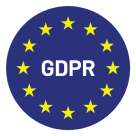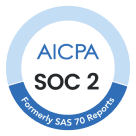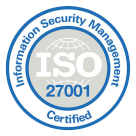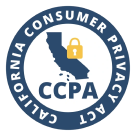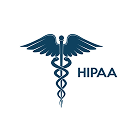Call Center Quality Management: Expert Guide on Optimizing CX

97% of customers say service quality influences their brand loyalty.* That’s why top-performing call centers need a strategic approach to call quality management.
Picture this: You’re digging through last month’s call performance reports, and the numbers aren’t where they should be: Customer satisfaction is dipping, average handle times are creeping up, and agent performance is below set targets.
The problem? Call quality.
Without a clear strategy to measure and improve call quality, small issues snowball into bigger ones, leading to frustrated customers and missed sales opportunities. So how do you ensure every call meets high standards without losing efficiency?
In this guide, we’ll walk you through the process of establishing an effective call quality management program. You’ll learn how to improve customer satisfaction, boost agent performance, and leverage AI-driven insights.
Key takeaways:
- Success in call quality management requires a transparent evaluation framework. Breaking down quality scores into weighted categories creates clear expectations across all organizational levels.
- Quality management directly impacts the bottom line: When call centers implement structured quality programs, they see measurable improvements in customer satisfaction, first-call resolution rates, and agent retention.
- CloudTalk’s AI-powered call quality management tools enable call centers to monitor 100% of calls leading to more comprehensive insights and coaching opportunities.
Enhance call quality with AI and real-time monitoring
Why Call Quality Management Matters for CX and Business Performance
Call centers that commit to quality management see immediate improvements in customer service delivery, customer loyalty, and employee engagement.
Over time, these efforts lead to more efficient operations and a better experience for customers and employees.
Key Benefits of a Strong Call Quality Strategy
Here are some key benefits you can expect from a strategic approach to managing call quality:
- Higher customer satisfaction: Optimized scripts and real-time feedback help agents deliver top-tier customer service, which leads to higher CSAT scores.
- Better first-call resolution (FCR) rates: When agents are properly trained and monitored, they resolve issues more effectively.
- Stronger agent performance: Agents may be totally unaware they’re rushing through calls or missing key details. With structured quality programs and consistent feedback, they can recognize and address those issues.
- Reduced customer churn: Unsatisfied customers churn with higher frequency. Quality monitoring helps you keep clients happy and increase brand loyalty.
- More consistent brand experience: Standardized quality monitoring ensures every customer interaction aligns with your brand values and communication guidelines.
- Data-driven decision-making: Quality management programs generate valuable insights about customer needs, agent performance, and operational efficiency. This data helps you make informed decisions about training, staffing, and process improvements.
- Increased compliance and risk management: A single compliance breach can jeopardize client trust and tarnish your reputation. Regular call monitoring helps identify and address compliance issues before they become serious problems.
- Scalability through automation: When you’re running a high-volume call center, manually reviewing each call just isn’t realistic. Modern quality management systems leverage AI and automation to analyze more calls and flag trends early.
Common Challenges in Call Quality Optimization and How to Solve Them
You already know that call quality is crucial to your business’s success, so what’s standing in the way? Many contact center leaders run into these common roadblocks when rolling out a quality management program:
- Inconsistent quality scoring: Quality analysts often interpret evaluation criteria differently. Inconsistencies in evaluation standards can be frustrating for agents. Standardized rubrics and regular calibration sessions keep scoring consistent across teams.
- Delayed feedback cycles: By the time managers review calls and provide feedback, agents may have repeated the same mistakes hundreds of times. Real-time monitoring and automated alerts can help address issues as they occur.
- Resource-intensive QA processes: Manually monitoring call quality is time-consuming—you have to listen to calls, score interactions, and provide feedback. In the best practices section, we’ll show you how to use automation to speed up the process.
- Lack of actionable insights: Many QA strategies generate scores but managers struggle to translate them into meaningful improvements. Data visualization tools and structured coaching programs help bridge this gap.
- Complex compliance requirements: Consumers regularly use at least four different channels to interact with brands. Maintaining compliance across thousands of agent interactions while meeting quality control targets is highly challenging. Automating processes helps you maintain standards and visibility.
In the following section, we’ll explore how to address these challenges through a comprehensive quality management framework.
Listen to calls in real-time, discreetly assist agents, or join conversations as needed. Learn more about CloudTalk’s Call Monitoring.
7 Best Practices for Call Quality Management
To transform your call center’s performance across key areas like call quality, agent performance, and customer satisfaction, implement these proven strategies and address the challenges discussed above.
1. Set Clear, Measurable Quality Standards for Calls
Quality standards should be specific, measurable, and directly tied to customer satisfaction.
Here are some actionable tips to effectively measure call quality metrics:
Define Your Core Evaluation Categories
Effective call quality management starts with a clear, standardized evaluation framework. Everyone from executives to frontline agents should have a universal understanding of expectations and what “good service” means.
Here’s a sample structure you can start using right away:
Customer Experience (35% of score)
- Greeting and identification
- Active listening indicators
- Problem-solving approach
- Clear communication
- Call resolution and follow-up
Technical Accuracy (30% of score)
- Product/service knowledge
- System navigation speed
- Solution accuracy
- Policy compliance
Soft Skills (20% of score)
- Empathy and rapport
- Tone and language
- Adaptability to customer needs
- Professional demeanor
Efficiency (15% of score)
- Handle time management
- Hold time usage
- First-call resolution
- Process adherence
Create Detailed Scoring Rubrics
Once your categories are clear, translate them into specific scoring rubrics. This makes evaluations objective and actionable.
- Develop 1-5 scale definitions for each criterion
- Include specific examples of what constitutes each score level
- Add “auto-fail” criteria for critical compliance issues
Set Up Performance Thresholds
Define what “good” looks like by setting clear score benchmarks. These thresholds keep teams aligned and motivated.
- Minimum acceptable score: 80%
- Target score: 90%
- Excellence threshold: 95%
- Track trending scores over 30/60/90 days
Establish Monitoring Frequency
Regularly assess calls to ensure quality is consistent and expectations are met. Set clear frequencies based on agent experience:
- New agents: 10 calls per week
- Experienced agents: 5 calls per week
- Top performers: 3 calls per week
- Additional random sampling: 2% of all calls
Define Training Protocols
Clearly link training and coaching activities to performance outcomes. Your protocol should specify the response required at each performance level:
- Below 80%: Daily coaching sessions
- 80-89%: Weekly coaching
- 90-94%: Monthly check-ins
- 95%+: Quarterly reviews and peer mentoring opportunities
Implementation Tools
Support the whole evaluation and training process with appropriate technology. Key tools include:
- Digital scorecard template
- Real-Time Dashboard
- Automated scoring alerts
- Performance trending reports
- Calibration session materials
By establishing benchmarks, you create a foundation for quality evaluation and better customer service. Each standard should be recorded and reviewed regularly for relevance and effectiveness.
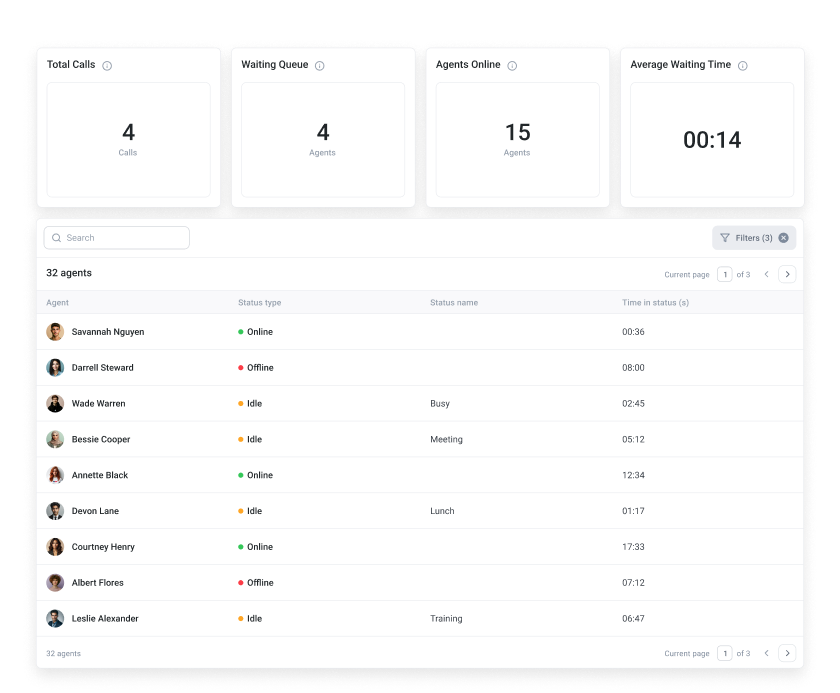
2. Use AI-Powered Call Scoring for Accurate Performance Insights
Traditional call center QA relies on manual evaluations which are time-consuming and resource-intensive. But assessing performance doesn’t have to be work-intensive.
AI automates quality analysis for live interactions across calls, emails, and chats, generating a key metric: The call quality score.
It also evaluates agent performance, including call flow, verification, procedural adherence, authentication, problem understanding, resolution, and soft skills.
By leveraging AI-powered call scoring, call centers can ensure consistent, data-driven performance evaluations, freeing up time for managers to focus on continuous improvements.
How to implement AI-powered call scoring:
- Automate call analysis: Use AI to evaluate live interactions across calls, emails, and chats. AI can assess call flow, verification, procedural adherence, authentication, problem understanding, resolution, and soft skills.
- Define key evaluation criteria: Train AI models to prioritize critical KPIs, such as compliance, script adherence, and customer sentiment.
- Integrate AI with call center tools: Solutions like CloudTalk implement AI-driven scoring, making it easier to track trends and pinpoint coaching opportunities.
3. Monitor Calls in Real-Time to Identify Issues Proactively
Imagine this: A customer calls in with a billing issue, and the agent provides incorrect information.
Without real-time monitoring, the mistake goes unnoticed until the customer calls back frustrated—or worse, churns.
But with real-time insights, your manager can step in immediately, correct the error, and coach the agent on the spot.
Real-time call monitoring allows you to address issues when it matters most. This proactive approach helps you maintain consistent service quality and preempt potential problems.
How to implement real-time call monitoring:
- Use monitoring tools: CloudTalk enables you to listen in on live calls, so you can intervene and offer guidance to call center agents when necessary.
- Monitor dashboards closely: Keep an eye on real-time dashboards to spot common issues (e.g. extended silence or compliance breaches), allowing managers to intervene immediately and address the situation.
- Provide immediate feedback: Use call center monitoring best practices to give agents real-time coaching, guiding them through the call for better outcomes.
- Track key metrics: Focus on metrics like call wait times, agent tone, customer sentiment, average handle time (AHT) and resolution speed. These indicators help you track performance improvements over time.
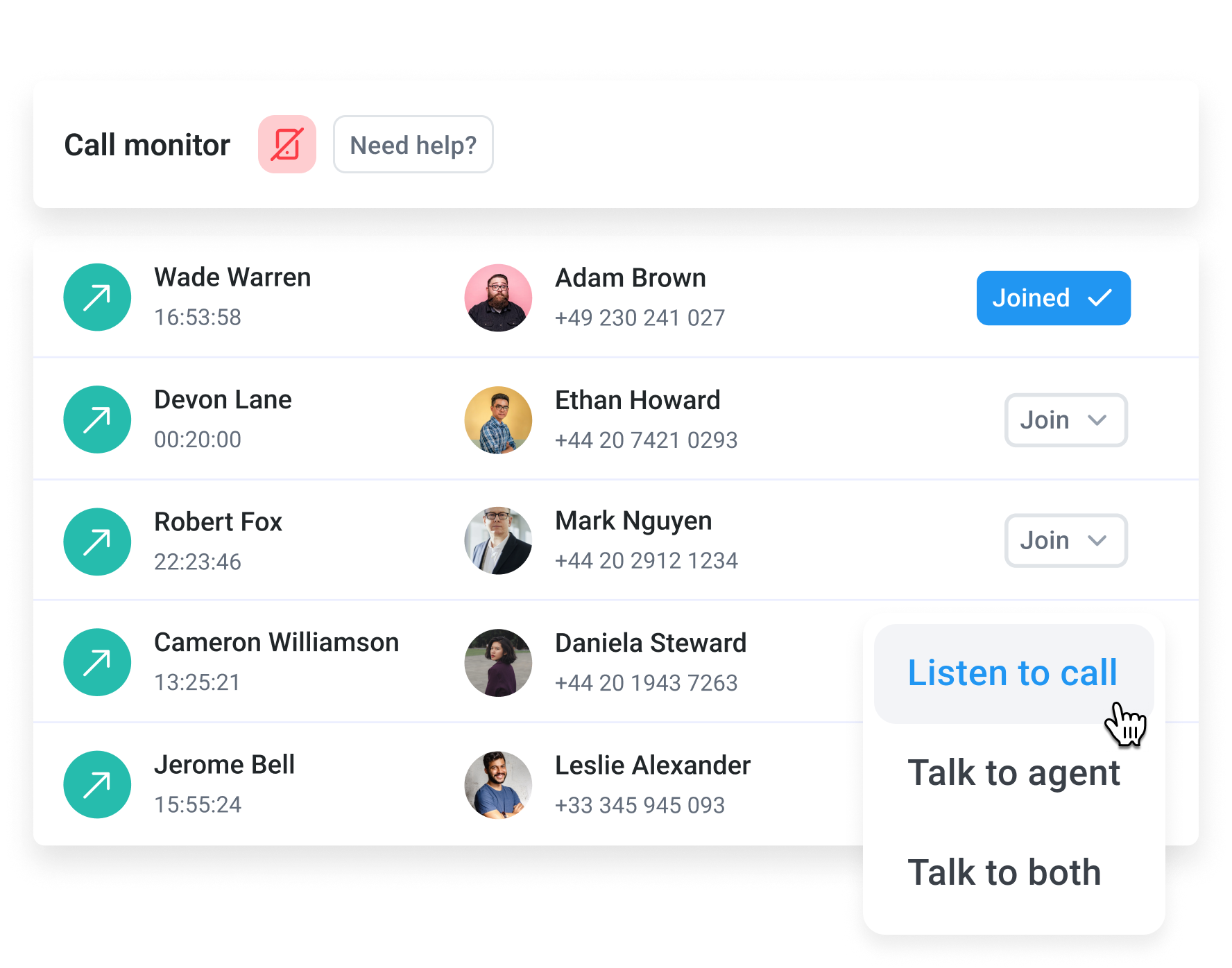
4. Implement Sentiment Analysis to Assess CX in Real-Time
AI-powered sentiment analysis takes customer interactions to the next level by analyzing emotional cues and adjusting responses in real-time. This allows for deeper personalization, so agents engage with customers in a way that feels tailored and responsive rather than robotic.
For example, imagine sentiment analysis detects rising frustration in a customer’s voice during a troubleshooting call. Your agent can quickly shift tactics, acknowledge the issue explicitly, and offer a personalized solution. This turns potential dissatisfaction into a positive experience.
How to implement sentiment analysis:
- Identify customer sentiment instantly: CloudTalk’s Sentiment Analysis can detect whether a customer is frustrated, neutral, or satisfied, so agents can adjust their approach on the spot.
- Tailor responses based on emotional cues: Equip agents with real-time insights to personalize their responses, offering proactive solutions.
- Improve training and agent performance: Sentiment analysis data lets you review and evaluate past interactions. Identifying areas where agents can improve helps you to adjust your training approach so it’s more targeted and effective.
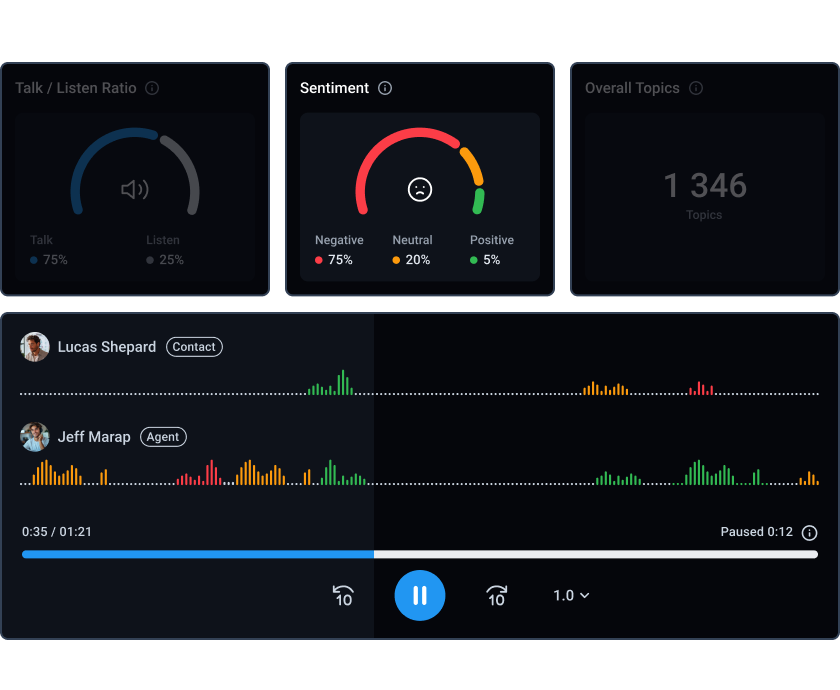
5. Automate QA Processes to Scale Quality Monitoring
Manual call quality monitoring is time-consuming and inefficient, especially as your call center grows.
If reviewing your current call volume feels impossible, imagine what it’ll look like when your team doubles or triples in size. Automation allows you to scale your quality monitoring processes alongside your business while enhancing accuracy or consistency.
How to automate QA processes:
- Implement automated quality monitoring tools: Use software like CloudTalk to automatically assess call recordings based on predefined metrics. This reduces the manual workload and speeds up evaluations.
- Focus on key metrics: Automate the tracking of important indicators such as call resolution rates, compliance, and customer satisfaction, ensuring consistent monitoring across all calls.
- Set up automated alerts: Automatically flag calls that fall below quality thresholds so managers can review and address them quickly.
- Leverage AI to improve scoring: Use AI-driven algorithms to assess agent performance and identify strengths and weaknesses.
6. Train Agents With Targeted Coaching Based on QA Data
Effective coaching begins with understanding where each agent needs improvement. By using data from your QA processes, you can provide tailored coaching that addresses specific performance gaps, boosting agent performance and customer satisfaction.
Best practices for targeted coaching:
- Analyze QA data: Review call scores and identify trends, such as recurring issues in call flow or customer interactions.
- Create personalized coaching plans: Use this data to design coaching sessions that focus on individual agent needs. These may include improving empathy, enhancing communication, or refining product knowledge.
- Provide immediate, actionable feedback: Equip managers to deliver timely feedback during or directly after calls, ensuring agents understand exactly how to adjust their approach while the interaction is still fresh.
7. Leverage Analytics to Continuously Improve Call Quality
Tracking analytics helps you understand not just what’s happening on individual calls but also the bigger picture of call center performance.
By leveraging these insights, you can identify and act on opportunities to improve call quality, making data-driven decisions that elevate your entire call center operation.
How to leverage analytics effectively:
- Track performance metrics over time: Use analytics tools like call center dashboards to visualize data and monitor trends in key metrics like resolution time, call sentiment, and customer satisfaction.
- Identify areas for improvement: Regularly review analytics to pinpoint issues, whether it’s common customer complaints or recurring performance gaps with specific agents.
- Establish a feedback loop: Use customer feedback to refine your quality standards and adjust strategies, creating a continuous cycle of improvement.
AI-Driven Insights Elevate Call Quality Monitoring
A recent Salesforce study found that 88% of customers say good customer service makes them more likely to purchase again.* This underscores why consistently maintaining call quality is critical for your bottom line.
Training agents with data-driven coaching and continuously improving your processes ensures your call center remains efficient, responsive, and customer-focused.
A strong quality assurance process doesn’t just help your agents achieve their performance goals, it also inspires increased customer loyalty and retention.
- Start by reviewing recent call data to identify recurring issues, such as common customer complaints or agent performance gaps.
- Then, test AI-driven monitoring on a small scale to analyze interactions in real-time and measure impact.
By gradually integrating automation, you’ll not only enhance service quality but also create an environment where agents can thrive and customers feel heard and valued.
Enhance call quality with AI and real-time monitoring
Sources:
Microsoft’s Global State of Multichannel Customer Service Report
FAQs about Call Quality Management
What Are the Most Important Call Quality Metrics to Track?
The most important call center quality assurance metrics to track for optimal performance include call flow, resolution, and customer sentiment.
How Can AI Improve Call Quality?
AI can help automate call scoring, evaluate agent performance, and provide real-time feedback to improve consistency across call center operations.
What’s the Best Way to Give Feedback to Agents Based on Call Quality Data?
Provide immediate, data-driven feedback that gives agents direct actions to take to improve their performance, like enhancing their empathy.
How Often Should Call Quality Evaluations Be Conducted?
Regular call quality evaluations should be conducted to make sure you’re moving in the right direction. Weekly or monthly evaluations are ideal.
What Are the Biggest Mistakes Businesses Make in Call Quality Management?
Use native speakers, provide cultural training, monitor interactions, and Some of the biggest mistakes include inconsistent evaluations, failing to track key metrics, and a lack of agent training.













